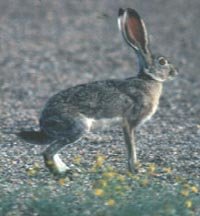Black-tailed Jackrabbit (Lepus californicus)

TPWD ©
- Description
- The Black-tailed Jackrabbit is a large, long-eared rabbit of the open grasslands and desert scrub of the West. Its fur is a dark buff color peppered with black, and its black-tipped ears are almost the same length as its hind feet.
- Life History
- The Black-tailed Jackrabbit spends most of its day resting in a scratched-out hollow in the ground. They are generally most active at dusk and throughout the night. Under the cover of darkness, they can forage with relative security.
Jackrabbits are strict vegetarians. During the spring and summer, they feed on clover, alfalfa and other abundant greens. During the lean fall and winter months, they subsist on woody and dried vegetation.
Jackrabbits always seem to be on their guard. They are very alert to their surroundings and watchful of potential threats. They rely on their speed to elude predators and, if they are lucky enough to escape, they will flash the white underside of their tail to alert other jackrabbits in the area.
Black-tailed Jackrabbits mate year round. They have one to four litters per year with one to eight young per litter. Young jackrabbits are born bright-eyed and active, and after only one month they can fend for themselves. Jackrabbits may live up to eight years in the wild but, like many other animals, they must contend with predators. Hawks, Coyotes and badgers are among the predators that regularly hunt jackrabbits. - Habitat
- Black-tailed Jackrabbits can be found on brushlands, prairies and meadows. They are often associated with pastures that have been grazed by livestock. Unlike other animals that need dense brush cover, jackrabbits use the high visibility of pasturelands to spot predators before they spot them.
- Distribution
- Jackrabbits are common throughout most of the western United States and in Texas except for the far eastern portions.